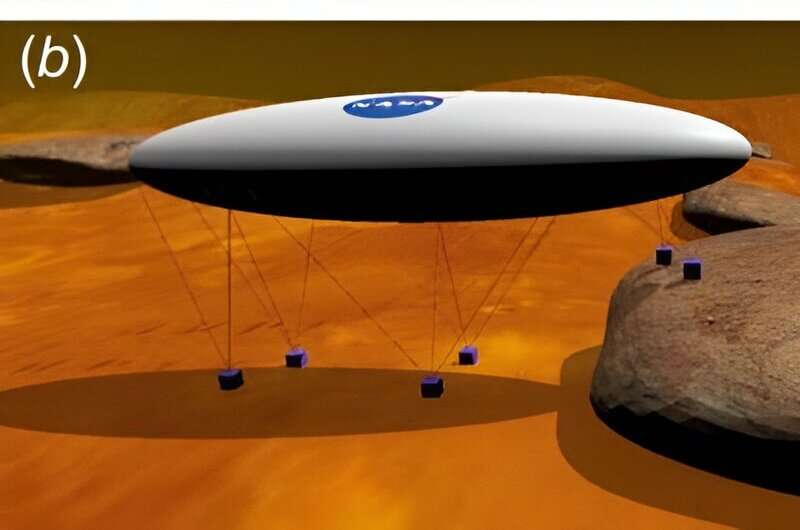This article has been reviewed according to Science X's editorial process and policies. Editors have highlighted the following attributes while ensuring the content's credibility:
fact-checked
trusted source
proofread
A walking balloon could one day explore Titan—or Earth's sea floor

Novel ways to move on other celestial bodies always draw the attention of the space exploration community. Here at UT, we've reported on everything from robots that suspend themselves from the walls of Martian caves to robots that hop using jets of locally mined gas. But we haven't yet reported on the idea of a balloon that "walks."
But that is the idea behind the BALloon Locomotion for Extreme Terrain, or BALLET, a project from Hari Nayar, a Principal Roboticist at NASA's Jet Propulsion Laboratory, and his colleagues.
How exactly does a balloon "walk," you might ask? By picking up and moving one of its six feet. BALLET's architecture involves a positively buoyant balloon supporting six "feet" attached to adjustable cables. The "feet" are small science packages capable of taking small surface samples or analyzing the chemical composition of the part of the surface it touches.
Each foot is attached to three cables, individually controlled by pulleys. When a foot is done doing its science work at a given location, BALLET retracts the cables for the foot, lifting it off the surface. It then extends the cables using different lengths for the cables to place the foot in a new location.
Preliminary research on the concept was done as part of a NASA Institute for Advanced Concepts (NIAC) grant in 2018. That research showed that it was better to lift two opposing feet off the ground at the same time to ensure the balloon's stability. It also demonstrated where the concept would be most useful—Titan.
Balloon locomotion is typically considered somewhere like Venus, where it could float in the atmosphere in conditions similar to Earth. However, that altitude would make controlling a payload placed on the ground exceedingly tricky. Additionally, the harsh conditions close enough to the ground to be feasible would make the material requirements of the system untenable.
Similarly, a balloon could also work on Mars, but the high wind speeds of the sparse atmosphere would make controlling the balloon difficult. Titan offers the best of both worlds—a relatively stable, thick atmosphere where a negatively buoyant balloon would be feasible and stable environmental conditions that wouldn't blow BALLET everywhere.
It also has many interesting places to explore, including cryovolcanoes and methane lakes. BALLET would allow traversal over even some of the most difficult terrain without accounting for considerations that would dramatically affect the capabilities of either a rover or a helicopter, such as the planned Dragonfly mission.
There are still plenty of design considerations, though, such as the difficulty of controlling all the different variables, such as balloon orientation, cable length for each of the 18 cables, and pathfinding, simultaneously. After the completion of the Phase I project, the concept appears to be on hold in terms of receiving further funding from NASA at this point.
However, in terms of applications, BALLET also has some obvious ones on Earth. One that immediately sprang to mind is the collection of "nodules" as part of an undersea mining operation.
Given the increased need for cobalt and other materials provided in those nodules and the bad image that comes from the destruction of the seabed that comes with traditional mining techniques, this idea might be one of those rare space exploration ideas that sooner sees an application on Earth than off of it.
Provided by Universe Today





















